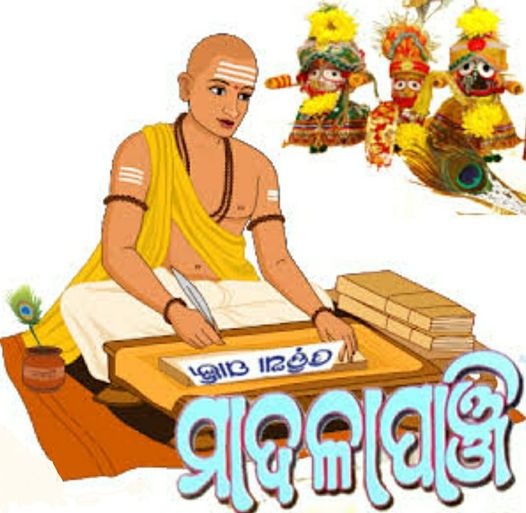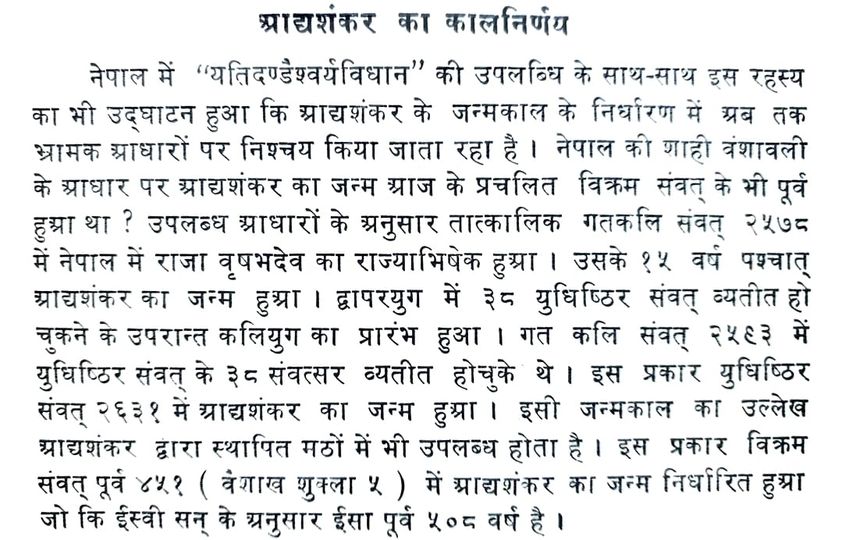28th October 2020 : Edneer Matha Shri Sachidananda Bharati Swamiji Pattabhisheka
Author: Shankarasampradayakosh
Madalapanji’s Lasting Legacy : Sacred Honors to Five Shankara Mathas in Puri Jagannath Temple Revealed
The Madalapanji, palm-leaf Odia chronicles of Jagannath temple in Puri, holds immense historical importance, not only for its comprehensive account of Odisha’s traditional history but also for the significant status it attributes to the Mathas established by Pujyashri Shankara Bhagavatpadacharya within the Temple’s historical framework.
This ancient record is comparable to Srirangam & Kanchipuram Kovil-Ozhugu and Sritala Pustaka & sthanikar varalaru of Madurai Temple of Tamilnadu.
Written annually, the Madalapanji was meticulously maintained by the Karanas, the official history writers of Puri. The ritual of updating the chronicle on Vijaya Dashami day serves as evidence that the tradition began with Odia king Anantavarman Chodaganga Dev himself.
It is said that 24 Karana families were engaged to safeguard these records of Puri Temple, with five specifically assigned to the writing and preservation of the Madalapanji. These designated Karanas include –
Panjia Karan (preserver)
Tadau Karan (writer)
Deula Karan (enforcer)
Kotha Karan (main compiler), and
Baithi Karan (assistant).
Raja Ramachandra Dev’s order in respect of the Traditional Honours shown to the Five Shankaracharya Mathas :
Within the Madalapanji, an intriguing mention can be found regarding the honors bestowed by Raja Ramachandra Dev upon the five Shankaracharya Mathas. This particular reference underscores the significance attributed to these mathas within the temple’s historical context.
According to Shri Sadashiv Rath, in leaf No.7 of Bundle No.3 in Dwarakanath Pattjiatri Mahapatra’s Private Library, reference is made in it to honours ordered by Raja Ramachandra Dev to the five Shankaracharya Mathas – Shri Kanchi Kamakoti, Badarikasrama, Dwaraka, Sringeri and Puri Govardhana Mathas. (1/2)
Dakshinamurti Matha, Benares
In the cultural heritage of India two streams viz, Pravirtti and Nivritti based on the Vedas are flowing. For these two streams the original canal is Lord Siva in the form of Uma and Mahesvara. This form indicates the path or Pravirtti. For the path of Nivritti the form of Dakshinamurthy is the original source.
In Northern India, when many temples were razed to the ground, during the Mughal period, the tradition of Dakshinamurthy came to fade. From Bengal to Baluchi and Kashmir to Kerala, the upasana of Dakshinamurthy is observed to this day. Yet the scarcity of temples for external worship of Dakshinamurthy are very few.
His Holiness Satchidanandagiri has constructed a temple of Dakshinamurthy near the old temple of Siddhantha Mani where he himself meditated upon Dakshinamurthy. Probably this is the Matha referred to as Dakshinamurthy Matha, at Kasi.
The Guruparampara of Dakshinamurthy Matha also called Dhruvesvara Matha, Varanasi is as follows :-
1. Managiri
2. Meghagiri
3. Ramagiri
4. Satchidanandagiri
5. Amarendragiri
6. Manishagiri
7. Ramananda Giri
8. Nrisimha Giri
9. Niranjana Giri
10. Krishnananda Giri
(This brief note was prepared from ‘Gandivam’-Chaitra Sukla Prathama, 24-3-1974 By Sri Anandanandendra Swami of Sri Upanishad Brahmendra Matha.)
Rulers Unaware of Sri Sankaracharya :
Why were the rulers of Thamilagam during the 8th and 9th centuries C.E unaware of Sri Sankaracharya?
Proponents of the 788 C.E theory need to explain why the rulers of Tamilnadu, Andhrapradesh, Karnataka, and Kerala between the 8th and 9th centuries CE, who supported different faiths, had no connection with Sri Sankaracharya, despite His reported extensive travels during that time. It is surprising that they did not recognize His presence, and there is no record of Him in contemporary literature.
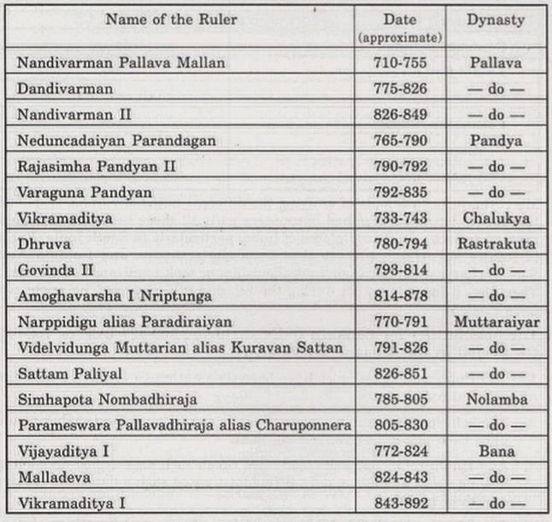
Sri Avani Sringeri Matha – Vijnapana Patrika
Sri Avani Sringeri Matha,
Avani Kolahalapuri Kshetra
Sri Abhinavoddanda Vidyashankara Bharati Swami
Date of Birth: 01-11-1908
Date of Sanyasashrama : 02-05-1928
Image Vijnapana Patrika submitted to Sri Abhinavoddanda Vidyashankara Bharathi Swami of Sri Avani Sringeri Matha, who presided over the Seventh Sammelana of the Agama-Traya Mahamandala by the Adyaksha, upa-adyaksha and participants on August 22, 1956 in Bangalore.
//… Śrī śrīgaḷavaru nam’ma sansthānada suprasid’dha kṣētragaḷallondāda kōlāhalapurī kṣētra (kōlāra) dalli janmatāḷi atyalpa kāladalli, anāyāsavāgi, tarka sāhitya, vēda vēdāntādi śāstrādhyayana māḍi pūrṇa pāṇḍityavannu paḍeda nidarśana mātradindalē śrī śrīgaḷavara pratibheyannu tiḷiyabahudāgide. Śrī śrīgaḷavaru beṅgaḷūrinalliddāga cikka nam’ma naravāgiddara āgalē svāśramōcitavāda anuṣṭhānada mahimeyinda bhaktajanateyannu śrīmaṭhada kaḍege olisikoṇḍu, cāturmāsya, śarannavarātri muntāda viśēṣōtsavagaḷannu vaibhavadinda naḍeyisiruvudannu nōḍi nalida jana ā ānandavannu indigū mareyalāgilla.
Śrī śrīgaḷavaru 1934 ralli dakṣiṇadēśa pravāsa horaḍuva mun̄ce maisūru śrīmanmahārājaravarāgidda nālvaḍi śrī kr̥ṣṇarāja oḍeyaravaru mahāsannidhānada upayōgakkāgi cinnada pan̄cakalaśada myānā ondannū hāgu kudure modalādavu gaḷannū beṅgaḷūru mokkāṅge bhaktiya kāṇikeyāgi samarpisiddannu nōḍiddēve
…
Avani śr̥ṅgēri śrī maṭhadalli ādiyindalū tapasvigaḷū mahimāsampannarū āda pūjyaru maṭhādhipatigaḷāgiddu maṭhada abhivr̥d’dhige kāraṇarāgiddāre. Nam’ma sansthānada śaivāgamōkta dēvasthānagaḷalli mukhyavāda nan̄janagūḍina śrī śrīkaṇṭhē śvara svāmiyavara mahādvāra gōpurada suvarṇakalaśagaḷa sthāpaneyādāga śrī kīlaka sanvatsaradalli’āga śrī āvani śrīmaṭhadalli virājisuttidda śrī svāmigaḷavarannu āḷida mahāsvāmiyavarāda mum’maḍi kr̥ṣṇarāja oḍeyaravaru rājamaryādegaḷoḍane baramāḍikoṇḍu śrī śrīgaḷavara divya sam’mukhadalli kalaśasthāpaneyannu neravērisida nidarśanavondē śrīmaṭhada gauravakke sākṣiyāgide.
Ā mahāpuruṣara parampareyalli banda yativaryarugaḷanteyē śrī śrī abhinavōdaṇḍa vidyāraṇya bhāratīsvāmigaḷa varāda tāvu śrī r̥ṣyaśr̥ṅgarante suvr̥ṣṭi pradarū, śrī hayagrīvarante jñānanidhigaḷū, śrī dakṣiṇāmūrtiyante tappō mūrtigaḷū bhaktavatsalarū āgiddīri….//
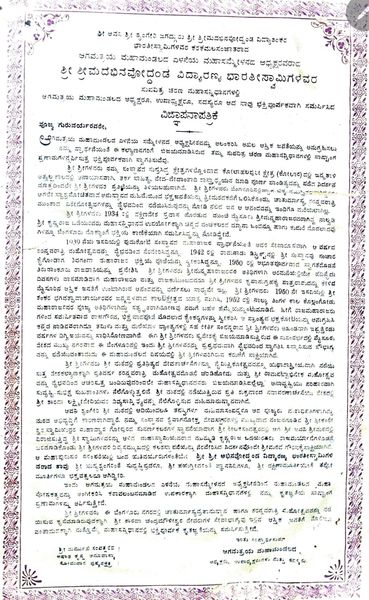
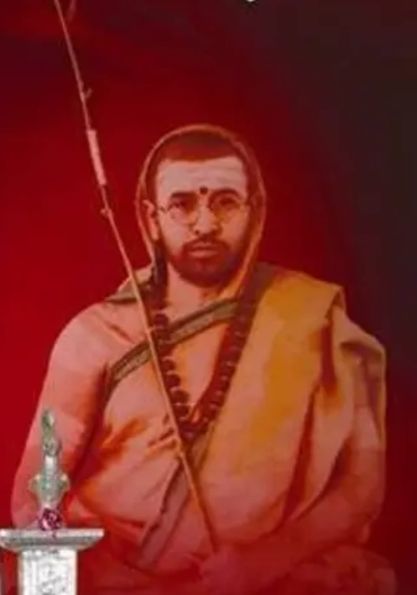
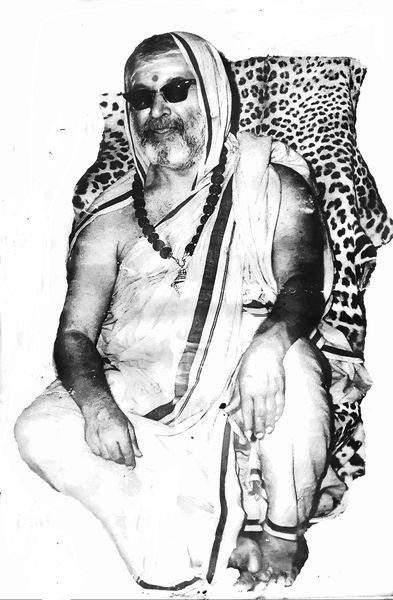
Cordial relationship – Sri Hariharapura Matha And Sri Kanchi Kamakoti Peetha (1923)
Evidence for enduring cordial relationship: Sri Hariharapura Matha And Sri Kanchi Kamakoti Peetha (1923)
Sri Swayamprakasa Ramananda Saraswathi Swami of Sri Hariharpura Matha Conveys Inability to Attend Tatanka Prathishta Festival at Jambukeswaram & Sending Delegation from Sri Hariharpura Matha.
This correspondence, dated 18, April 1923, exemplifies the enduring and amicable bond between these two advaitic institutions, which has persisted for over a century.
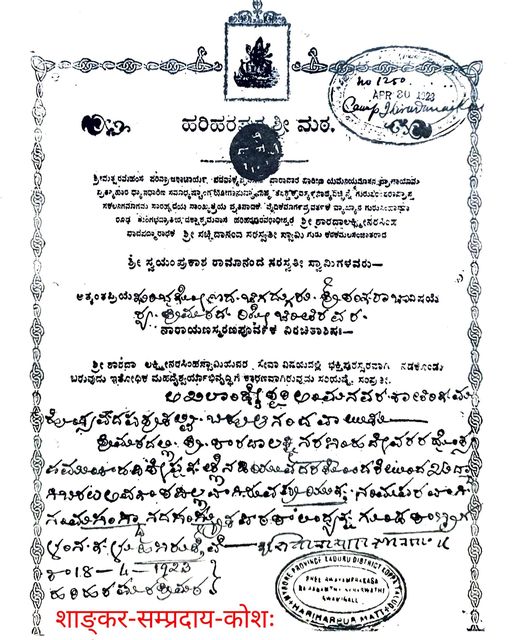
आद्यशंकर का कालनिर्णय – भूमिका
ANANDAGIRI SANKARA VIJAYA (1867)
This book predates the 1868 Calcutta edition of Anandagiri Sankaravijaya in Devanagari Script, edited by Jayanarayana Tarka Panchanana, by a year.
Why this rare book has not been noticed by both Indian and foreign researchers so far is very obvious.
With the Divine Blessings of Sri Sankara Bhagavatpadacharya, the Shankara Sampradaya Kosh brings out the front cover image of this rare book to the attention of the Readers for the first time.
Image: ANANDAGIRI SANKARA VIJAYA (1867)
First Original Publication of Sankaravijayam in Telugu Script – Printed by Saraswativilasa Mudrasala.
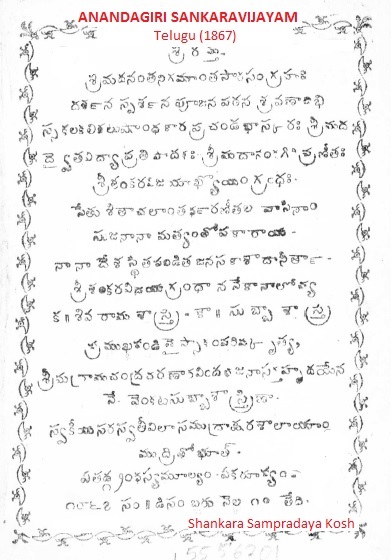
Mandana Mishra Agrahara And Vidyaranyapura: The Truth About double speak
Some scholars present the existence of “Vidyaranyapura”, a settlement established by the rulers of Vijayanaga, near Tunga Sringeri, to support its connection to Sri Vidyaranya Swami.
Strangely, the same group of scholars denies the existence of Mandana Mishra Agrahara in Kanchi Kshetra, where many migrated Mishra families from Bihar had their home. This Settlement serves as evidence of the connection between Sri Suresvara and Kanchipuram, the * only * Mokshapuri in South India where Sri Sankaracharya and Sri Suresvararacharya attained Samadhi.
This contradictory stance indicates their hidden motive, extending beyond the objective pursuit of historical evidence.
Image: Jagadguru Sri Sankara Bhagavatpadacharya Charitra (1919) Published by a descendant of Sri Manda Mishra in Kanchipuram.
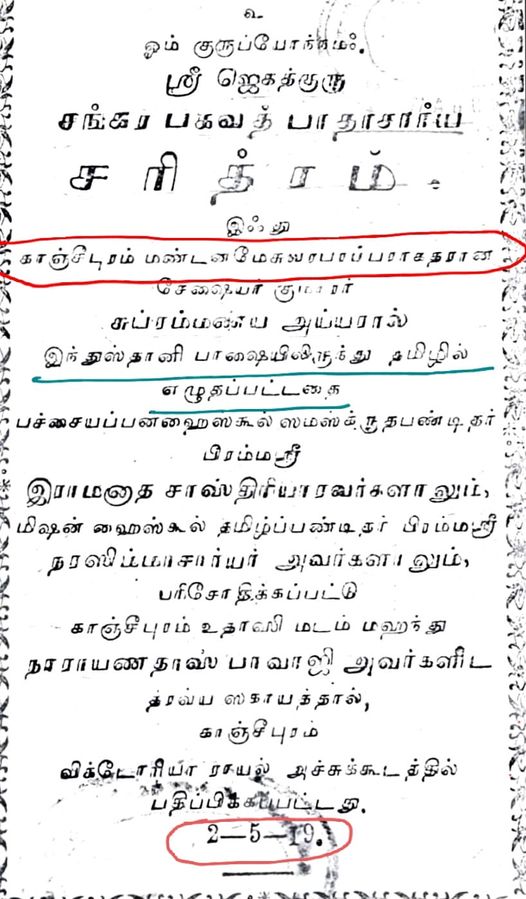
FAQs – Shakha Mathas – History
“Annual Tributes and Historical Connections: Sivaganga and Avani Mathas’ Relationship with Tungabhadra Kudali Sringeri Matha”
Q: What evidence supports the fact that Sivaganga and Avani Mathas had been making annual tributes or offerings to the Tungabhadra Kudali Sringeri Matha?
A: The evidence includes letters from Sivaganga Matha dated Khara, Kārtika Suddha 15, Salivahana Saka 1633, 1711 A.D. and the letter bearing Vyaya, Śaka, 1635, 1713 A.D. Additionally, letters from Avani Matha dated Vyaya, Magha Suddha 15, Salivahana Era, 1635, 1714 A.D. and Jaya, Salivahana Saka 1636, 1715 A.D. also support this fact.
Q: Is it historically correct to consider Sivaganga and Avani mathas as the Shakha or Branch mathas of Tunga Sringeri matha?
A: No, treating Sivaganga and Avani mathas as the shakha or Branch mathas of Tunga Sringeri matha is not historically accurate.
(Source: Preceptors of Advaita- Sankara And Sankarite Institutions: Sri Anantanandendra Saraswati Swami, Upanishad Brahmendra Matha)

